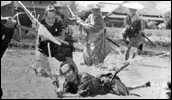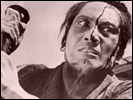The Great Killing
- Year
- 1964
- Original title
- Daisatsujin
- Japanese title
- 大殺陣
- Alternative title
- The Great Battle
- The Great Melee
- Director
- Cast
- Running time
- 118 minutes
- Published
- 24 October 2005


by Tom Mes
In and out of genre, the 1960s were one of the most fascinating decades in Japanese film history. With the social climate feeding an air of dissent, the movies followed suit and became more openly critical of hierarchy, power structures and injustice.
The most renowned manifestation of this is of course the Japanese New Wave, with a man like Nagisa Oshima taking his camera out into the streets and into the melee of anti-war protests and student riots. These developments also deeply affected the chanbara film, which rivalled the films of the New Wave directors (and occasionally crossed over with them, as with Masahiro Shinoda's Samurai Spy and Assassination) in their hard-hitting criticism of everything that was turning sour in the seemingly democratic society of post-war Japan.
These critical chanbara of the 1960s, spearheaded by such directors as Masaki Kobayashi, Hideo Gosha, Kihachi Okamoto and Kenji Misumi - not by coincidence all men who had lived through the horrors of the battlefield and returned from them with a great distrust of authority - took the age-old giri-ninjo conflict embedded in period fiction and began using it not just to create potent drama, but to lay bare the inhumanity of a society built on unconditional duty and obligation to the leaders of the land. Their films may have been set in the Tokugawa period, but as with all great period pieces, what they were really talking about were their own times.
Eiichi Kudo's The Great Killing (a.k.a. The Great Melee) is one of the finest examples of how directly the chanbara spoke about what was going on in the streets of Tokyo during the 1960s. In the interview in Chris D's book Outlaw Masters Of Japanese Film, the director explains how its story of a group of deceived, taxed-to-the-eyeballs samurai plotting the assassination of the shogun's heir was an allegory for the increasingly violent and politicised struggles of the student protest movement of the day. The four men and one woman that unite to carry out the killing have all, in one form or another, been the victim of the backroom machinations of powerful bureaucrat Sakai, who plans to bring the youngest heir to the shogunate throne to power and rule the country in his place.
The audience identification figure is Jinbo (Satomi), a young swordsman whose wife was needlessly killed by an overzealous battalion of government forces hunting for dissenters. On the run and alone, Jinbo initially crosses paths with a shabby, hedonistic ronin (Hira, who played the lead in Hideo Gosha's Sword of the Beast the following year) who has turned his back on society and politics. After spending a night at his hide-out, Jinbo leaves him, disgusted at his apolitical stance, and goes in search of more likeminded company, eventually falling in with the aforementioned group of conspirators led by a wealthy patron.
The film plays itself out in a series of carefully composed, studied scenes of backroom intrigue, which grow increasingly strained and jittery as the assassination approaches and the pulses begin to race. The characters begin to reveal more and more of their weaknesses as the big day comes closer, leading to tears in the carefully woven fabric of the plot: the female member is killed by her oversexed co-conspirator when she refuses his advances, while another chickens out at the last moment, leaving his friends to fend for themselves in the heat of battle. When the great killing/battle/melee of the title finally arrives, and the rebels attempt to corner the prince's procession in the entertainment district of Yoshiwara, director Kudo amps up the chaos, confusion, and helplessness by shooting the scene entirely with handheld cameras, creating an even more furious and intense result than that achieved by his friend and Toei studiomate Kinji Fukasaku. The lengthy sequence tests its audience to the breaking point with its prolonged, harrowing vision of uncontrolled - and uncontrollable - carnage. Rebels, government troops, and innocent bystanders alike lie scattered in the mud, screaming, crying, and bleeding as the attempt to kill the puppet prince turns into a grotesque farce.
Making his debut at Toei in 1959 with a pair of sixty-minute short features, Eiichi Kudo has remained almost entirely unknown outside Japan. The one film that seems to have made any kind of impact on the international scene also happened to be his last, A Tale of Scarfaces (Ando Gumi Gaiden: Gunro no Keifu, 1997), made three years before his death. As German genre movie maven Olaf Möller claims, Kudo was always appreciated by his colleagues, but never became fashionable and thus never received his moment in the spotlight. During his time with Toei he alternated chanbara and yakuza films, including the ninth and final instalment in the Battles Without Honour and Humanity series (Sono Go no Jingi naki Tatakai, 1979). In the 1980s came a move to television and a string of big-screen noirish cop thrillers, including Yokohama BJ Blues, a film that allowed that decade's biggest star, Yusaku Matsuda, to rise above the standard tough-guy action fare he had been saddled with in the previous decade. Kudo continued alternating between contemporary crime films and period action movies for the remainder of his career.
On the evidence of The Great Killing alone, it's clear that Japanese film fans have been derived of an immense talent. Eiichi Kudo was a filmmaker on a par with his better-known contemporaries and badly needs rescuing from his undeserved obscurity. Especialy in the wake of Takashi Miike's widely seen and praised remake of Kudo's 13 Assassins, one may wonder which film festival is going to grab the glory by organising the first Eiichi Kudo retrospective?